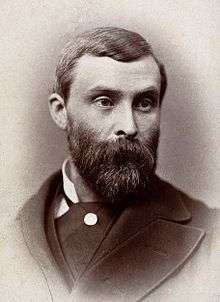Lauder Brunton
Sir Thomas Lauder Brunton, 1st Baronet, FRS (14 March 1844 – 16 September 1916) was a Scottish physician who is most-closely associated with the use of amyl nitrite to treat angina pectoris.
Sir Lauder Brunton | |
|---|---|
 Brunton in 1881 | |
| Born | 14 March 1844 Roxburgh, Scotland |
| Died | 16 September 1916 (aged 72) London, England |
| Nationality | Scottish |
| Other names | Jalaluddin Lauder Brunton |
| Known for | Treatment of angina pectoris |
| Spouse(s) | Louisa Jane Stopford
( m. 1879; died 1909) |
| Awards | Cameron Prize for Therapeutics of the University of Edinburgh (1915) |
Biography
Brunton was born on 14 March 1844 in Roxburgh in southeastern Scotland, the son of James Brunton (1781–1863) and his second wife Agnes Stenhouse (1807–1848). James's first wife was Euphemia Lauder (1794–1822), which gives explanation for his middle name, although he was not directly related to the Lauder's of the Bass.[1] He studied medicine at the University of Edinburgh, beginning research into pharmacology while still a student there, and receiving a gold medal for his 1866 thesis on digitalis. Following additional work in Austria, the Netherlands, and Germany, Brunton returned to University College, London, and while there he was selected for a position at St. Bartholomew's Hospital. Brunton's clinical use of amyl nitrite to treat angina was inspired by earlier work with the same reagent by Arthur Gamgee and Benjamin Ward Richardson. Brunton reasoned that the pain and discomfort of angina could be reduced by administering amyl nitrite to open the coronary arteries of patients. In 1874, Brunton was made a Fellow of the Royal Society. He delivered the Goulstonian Lecture in 1877 on "Pharmacology and Therapeutics" and the Croonian Lecture in 1889 on "The Chemical structure of Physiological Action", both to the Royal College of Physicians. He was appointed a Knight Bachelor in the 1900 New Year Honours list, received the knighthood by Queen Victoria at Osborne House on 9 February 1900,[2] and was made a baronet in 1908.[3] In 1915, he was awarded the Cameron Prize for Therapeutics of the University of Edinburgh. Brunton married Louisa Jane, daughter of Edward Stopford, Archdeacon of Meath, in 1879. She died in 1909.
Brunton died in London on 16 September 1916, aged 72, and was buried in Highgate Cemetery. His memorial was designed by Sir Robert Lorimer. Lorimer also designed a plaque to Brunton in Bowden in Roxburghshire, erected in 1920.[4]
He was succeeded in the baronetcy by his eldest son Stopford Brunton. Another son, Lt. Edward Brunton, was killed at the Battle of Loos.
Some of Brunton's papers are held at the National Library of Medicine.[5]
Lauder Brunton later converted to Islam and took up the name Jalaluddin Lauder Brunton.[6][7]
Selected works
- Brunton, T. Lauder (1875). Experimental Investigation of the Action of Medicines. London: J. and A. Churchill.
- Brunton, T. Lauder (1880). Pharmacology and Therapeutics, or, Medicine Past and Present. London: Macmillan and Company.
- Brunton, Thomas Lauder (1885). A Textbook of Pharmacology, Therapeutics, and Materia Medica. London: Macmillan and Company.
- Brunton, T. Lauder (1886). On Disorders of Digestion, Their Consequences and Treatment. London: Macmillan and Company.
- Brunton, Lauder (1915). Therapeutics of the Circulation (2 ed.). New York: Paul E. Hoeber.
Lauder Brunton.
References
- James Brunton Grave Headstone
- "No. 27167". The London Gazette. 20 February 1900. p. 1169.
- "No. 28158". The London Gazette. 14 July 1908. p. 5133.
- Dictionary of Scottish Architects: Robert Lorimer
- "Sir Thomas Lauder Brunton Correspondence 1881–1912". National Library of Medicine.
- Ron Geaves (21 December 2010), Islam in Victorian Britain: The Life and Times of Abdullah Quilliam, p. 269, ISBN 9781847740380
- M. Sıddık Gümüş, Why did they become muslims?
Further reading
| Wikimedia Commons has media related to Lauder Brunton. |
| Wikisource has original works written by or about: Thomas Lauder Brunton |
- Fye, W. Bruce (1986). "T. Lauder Brunton and Amyl Nitrite: A Victorian Vasodilator" (PDF). Circulation. 74 (2): 222–229. doi:10.1161/01.cir.74.2.222. PMID 3524895.
- C. A. (1917). "Thomas Lauder Brunton, 1844–1916". Obituary Notices of Fellows Deceased. Proceedings of the Royal Society B: Biological Sciences. 89 (622): xliv–xlviii. doi:10.1098/rspb.1917.0010.
- Brief summary of Brunton's work
- Baronetcy of Brunton and his successors
| Baronetage of the United Kingdom | ||
|---|---|---|
| New creation | Baronet (of Stratford Place) 1908–1916 |
Succeeded by Stopford Brunton |